Sign-up for our portal to download all our scientific research publications and more.
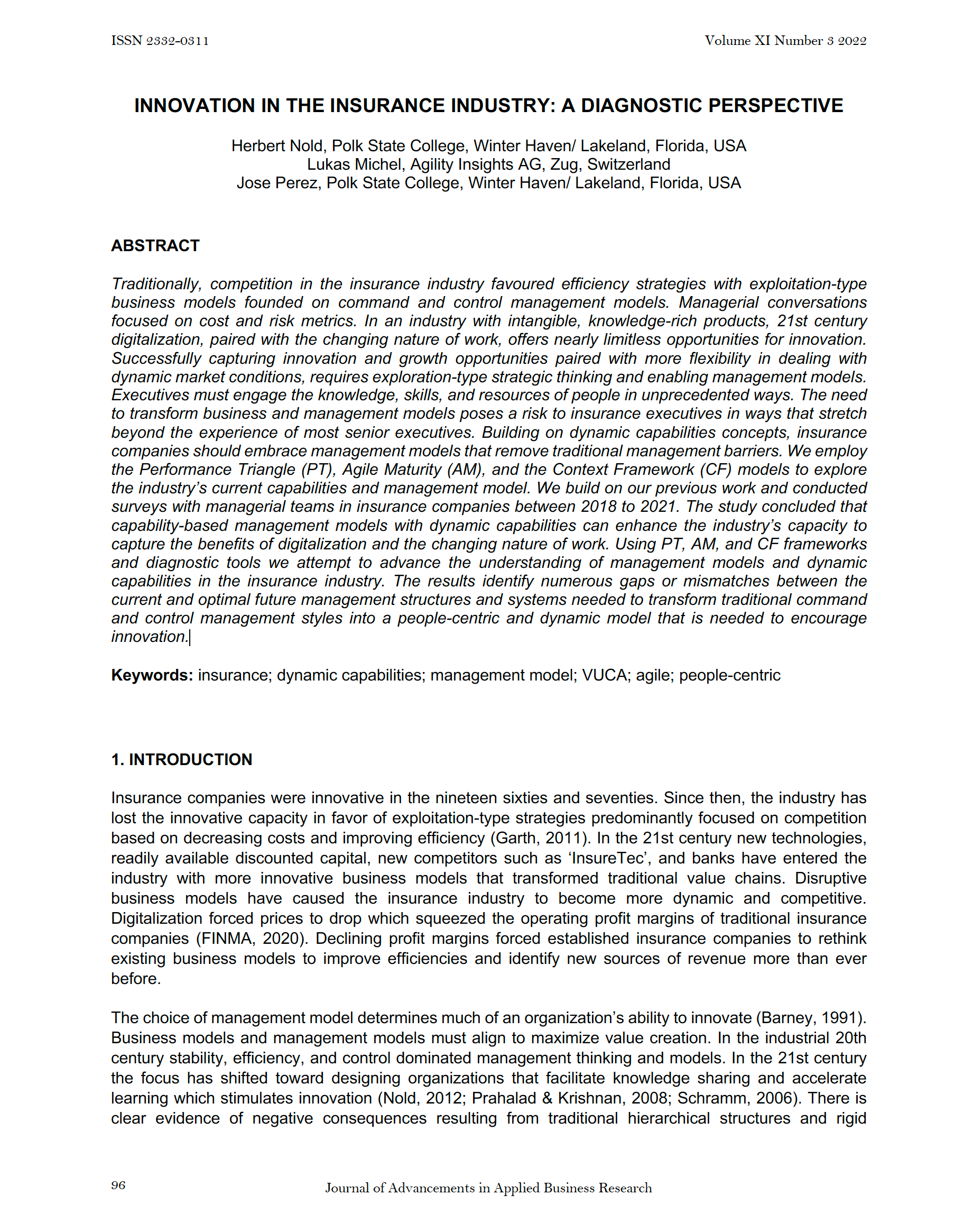 |
Innovation in the Insurance Industry: A Diagnostic PerspectiveAuthors: Herb Nold, Lukas Michel and Jose Perez Journal of Advancements in Applied Business Research, Volume XI Number 3, 2022 Traditionally, competition in the insurance industry favoured efficiency strategies with exploitation-type business models founded on command and control management models. Managerial conversations focused on cost and risk metrics. In an industry with intangible, knowledge-rich products, 21st century digitalization, paired with the changing nature of work, offers nearly limitless opportunities for innovation. Successfully capturing innovation and growth opportunities paired with more flexibility in dealing with dynamic market conditions, requires exploration-type strategic thinking and enabling management models. Executives must engage the knowledge, skills, and resources of people in unprecedented ways. The need to transform business and management models poses a risk to insurance executives in ways that stretch beyond the experience of most senior executives. Building on dynamic capabilities concepts, insurance companies should embrace management models that remove traditional management barriers. We employ the Performance Triangle (PT), Agile Maturity (AM), and the Context Framework (CF) models to explore the industry’s current capabilities and management model. We build on our previous work and conducted surveys with managerial teams in insurance companies between 2018 to 2021. The study concluded that capability-based management models with dynamic capabilities can enhance the industry’s capacity to capture the benefits of digitalization and the changing nature of work. Using PT, AM, and CF frameworks and diagnostic tools we attempt to advance the understanding of management models and dynamic capabilities in the insurance industry. The results identify numerous gaps or mismatches between the current and optimal future management structures and systems needed to transform traditional command and control management styles into a people-centric and dynamic model that is needed to encourage innovation. |
 |
The Dunning-Kruger Effect on Organizational AgilityAuthors: Herb Nold and Lukas Michel Academy of Management Annual Meeting Proceedings, 6 July 2022 Designing organizations to quickly adapt to changing conditions, agility, has become a key dynamic capability for success in the 21st century. The Dunning-Kruger effect suggests that people overestimate their ability and that of the organization because they are ignorant of unknown, unkowns. Said another way, people tend to overestimate their ability because they don’t know what they don’t know. Conversely, executives tend to underestimate the ability of subordinates in the organization. This research project used the Performance Triangle model and accompanying diagnostic instrument to analyze the difference in perceptions between executives and workers in 374 organizations to identify possible disconnects in important capabilities of organizational agility: success, leadership, systems, culture, people, and resilience, along with 27 underlying individual elements. The results show that executives consistently, and significantly, overestimate the ability of themselves and their organization to adapt a change while underestimating the capabilities of workers. Executives were significantly overconfident in the dimensions of success, culture, people, and resilience. Differences in trust emerged as the single most statistically significant element that drives organizational agility. The authors conclude with a discussion of the managerial implications on how this condition influences the ability of organizations to quickly adapt to changing conditions …agility. |
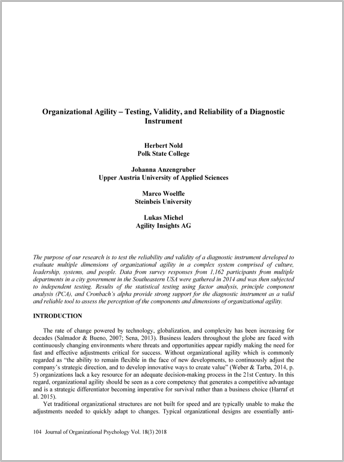 |
Organizational Agility - Testing Validity and Reliability of a Diagnostic InstrumentAuthors: Herb Nold, Johanna Anzengruber, Marco Woelfle, Lukas Michel Journal of Organizational Psychology Vol. 18(3) 2018 The scientific foundation of the Diagnostic The purpose of this publication is to test the reliability and validity of a diagnostic instrument developed to evaluate multiple dimensions of organizational agility in a complex system comprised of culture, leadership, systems, and people. Access the publication through your research platform or contact us. |
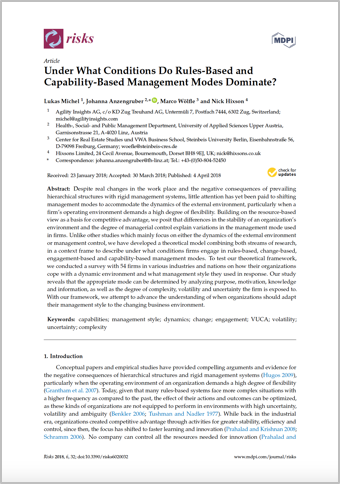 |
Under What Conditions Do Rules-Based and Capability-Based Management Modes Dominate?Authors: Lukas Michel, Johanna Anzengruber, Marco Wölfle, Nick Hixson Special Issue Risks in Financial and Real Estate Markets Journal, 2018, 6, 32. Access the article here: http://www.mdpi.com/2227-9091/6/2/32 The scientific foundation for the "Context Frame" Despite real changes in the work place and the negative consequences of prevailing hierarchical structures with rigid management systems, little attention has yet been paid to shifting management modes to accommodate the dynamics of the external environment, particularly when a firm’s operating environment demands a high degree of flexibility. Building on the resource-based view as a basis for competitive advantage, we posit that differences in the stability of an organization’s environment and the degree of managerial control explain variations in the management mode used in firms. Unlike other studies which mainly focus on either the dynamics of the external environment or management control, we have developed a theoretical model combining both streams of research, in a context frame to describe under what conditions firms engage in rules-based, change-based, engagement-based and capability-based management modes. To test our theoretical framework, we conducted a survey with 54 firms in various industries and nations on how their organizations cope with a dynamic environment and what management style they used in response. Our study reveals that the appropriate mode can be determined by analyzing purpose, motivation, knowledge and information, as well as the degree of complexity, volatility and uncertainty the firm is exposed to. With our framework, we attempt to advance the understanding of when organizations should adapt their management style to the changing business environment. |
|
|
Big Data AnalyticsTransforming Data to Action Authors: Daniel Bumblauskas, Herb Nold, Paul Bumblauskas, Amy Igou Business Process Management Journal, 23(3), pp. 703-720, 2017 Purchase from Emerald Publishing The Performance Triangle framework to transform data to action The purpose of this paper is to provide a conceptual model for the transformation of big data sets into actionable knowledge. The model introduces a framework for converting data to actionable knowledge and mitigating potential risk to the organization. A case utilizing a dashboard provides a practical application for analysis of big data. |
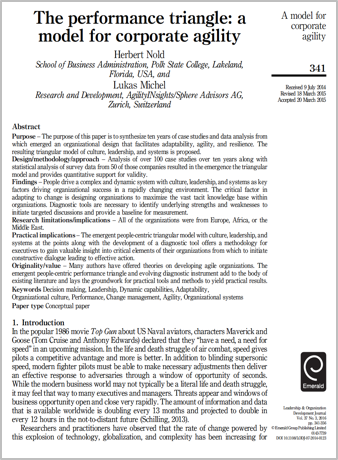 |
The Performance TriangleA Model for Corporate Agility Authors: Herb Nold and Lukas Michel Leadership & Organization Development" Journal, Vol. 37 No. 3, 2016. Purchase from Emerald Insights The scientific foundation of the performance triangle model relationships. The purpose of this paper is to synthesize ten years of case studies and data analysis from which emerged an organizational design that facilitates adaptability, agility, and resilience. The resulting triangular model of culture, leadership, and systems is proposed. Analysis of over 100 case studies over ten years along with statistical analysis of survey data from 50 of those companies resulted in the emergence the triangular model and provides quantitative support for validity. People drive a complex and dynamic system with culture, leadership, and systems as key factors driving organizational success in a rapidly changing environment. The critical factor inadapting to change is designing organizations to maximize the vast tacit knowledge base within organizations. Diagnostic tools are necessary to identify underlying strengths and weaknesses to initiate targeted discussions and provide a baseline for measurement. The emergent people-centric triangular model with culture, leadership, and systems at the points along with the development of a diagnostic tool offers a methodology for executives to gain valuable insight into critical elements of their organizations from which to initiate constructive dialogue leading to effective action. Many authors have offered theories on developing agile organizations. The emergent people-centric performance triangle and evolving diagnostic instrument add to the body of existing literature and lays the groundwork for practical tools and methods to yield practical results. |
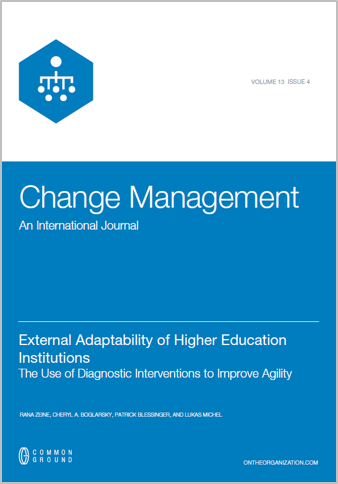 |
External Adaptability of Higher Education InstitutionsThe Use of Diagnostic Interventions to Improve Agility Authors: Rana Zeine, Cheryl A. Boglarsky, Patrick Blessinger, and Lukas Michel Change Management: An International Journal, Volume 13, Issue 4, 2014. Purchase the article from Common Grounds Publishers External Adaptability is an outcomes measure of organizational effectiveness reflecting proficiency levels in responding to external change. Many higher education institutions are interested in reshaping their goals to better meet the needs of a growing global market. To analyze External Adaptability, 52 higher education faculty and administrators from institutions in more than 16 countries were surveyed using the Human Synergistics International Organizational Effectiveness Inventory® (OEI®) Survey. Results revealed that External Adaptability scores fell below both the Historical Average (50th percentile) and the Constructive Benchmark. Subgroup analysis revealed that scores were below the Historical Average for faculty, administrators, males, females, and private- and public not-for-profits. By contrast, scores approached the Historical Average (50th percentile) in private for-profits, and exceeded the Constructive Benchmark in public for-profits. Trends for slightly higher scores were noted for administrators and males as compared to faculty and females respectively. To improve agility in higher education institutions, further diagnostic analysis of organizational decision making is warranted. The Performance Triangle diagnostic model is discussed and the use of the Diagnostic Survey from Management Insights AG is recommended. Attaining high External Adaptability is critical for the future of higher education. |
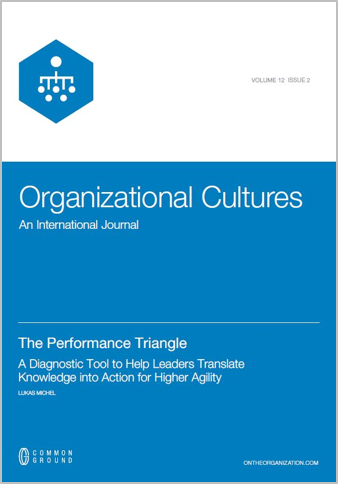 |
The Performance TriangleA Diagnostic Tool to Help Leaders Translate Knowledge into Action Author: Lukas Michel Organizational Cultures: An International Journal, Volume 12, Issue 2, June 2013. Purchase from Common Grounds Publishers It is so obvious: “People are the most important assets.” But good intentions are not good enough to win the game in today’s complex, uncertain, and knowledge-driven environment. The task is to make it real. First, this means getting people to collaborate and provide the means to find the purpose, rather than command and control. Second, to enable leadership teams to provide choice, to raise the awareness for what is important, and to help people to remain focused on the things that matter most. Leadership, systems, and culture frame the performance triangle. It offers both a diagnostic tool to help leaders decode and design the routines, rules, and practices for superior decision making, and a coaching approach with three parts: observation, response, and success. The insights from ten years of research with the diagnostic tool help leaders build organizations for superior innovation and growth. This paper will engage readers in a diagnostic with 10 observation points and 7 questions to help them coach leadership teams and build a working environment where people use their full potential to translate knowledge into action. |
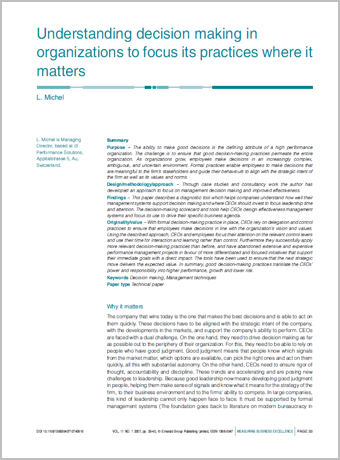 |
Understanding Decision Making in Organizations......to focus its practices where it matters most. Author: Lukas Michel Measuring Business Excellence, Jan/Feb 07, Vol 11. Purchase from www.emeraldinsight.com The ability to make good decisions is the defining attribute of a high performance organization. The challenge is to ensure that good decision making practices permeate the entire organization. As organizations grow, employees make decisions in an increasingly complex, ambiguous, and uncertain environment. Formal practices enable employees to make decisions that are meaningful to the firm’s stakeholders and guide their behaviors to align with the strategic intent of the firm as well as its values and norms. |